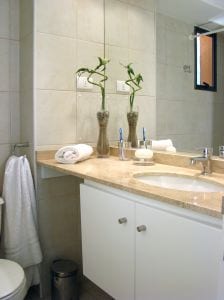
Your bathroom doesn’t have to sport pink shag carpeting and mint-green bath tiles to be outdated. If you’re ready to say sayonara to your old bathroom and usher in a era of pampering in the new year, it’s time to start looking at the exciting new technologies available on the market today that improve comfort and energy efficiency and conserve water.
These are three modern upgrades that will make your bathroom more of a destination than a utilitarian place for personal care, no matter how small your space is.
Tankless Water Heater
Although a new water heater will benefit the whole house, it’s most beneficial to the bathroom because really, what’s worse than having to fit all of the duties of a fifteen minute shower into three minutes because someone else in the house got their shower in before you and now there’s no hot water?
Tankless water heaters are also known as demand-type or instantaneous water heaters because they only heat water as it’s needed. When you turn on a hot water tap, cold water enters the tankless water heater and moves over a gas burner or electric heating element to heat it up.
The benefits of a tankless water heater include:
-
Better energy efficiency. Since there’s no heat loss associated with tankless water heaters, they’re considerably more energy efficient than models that store hot water in a tank. For a household that uses up to 41 gallons of hot water a day, a tankless water heater can save up to 34 percent on water heating costs. Those that use up to 86 gallons a day will save up to 14 percent. If you can afford to spring for additional tankless heaters installed at two or more hot water outlets, you can save up to 50 percent on hot water costs. When you consider that heating water in the home accounts for about 18 percent of your annual utilities, that’s a lot of savings.
-
Longer operating life. Standard water heaters that store hot water in a tank typically last between 10 and 15 years. Tankless water heaters, by comparison, have a typical operating life of longer than 20 years. So while they cost more initially, they pay for themselves over time through higher efficiency and longevity.
-
Less maintenance. Traditional water heaters require considerable maintenance to maintain efficiency, including flushing the tank every year and replacing the anode rod. Tankless water heaters require far less maintenance, mostly consisting of a periodic cleaning of the burner assembly or heating element.
-
Endless supply of hot water. Did we mention that you’ll never run out of hot water mid-shampoo?
A tankless water heater may not be the ideal solution for every household, because they do have some downsides:
-
Lower flow rate for simultaneous uses. The flow rate of a tankless water heater is two to five gallons per minute. Gas powered models have a higher output rate than electric models. What this means is that if you’re using multiple hot water taps at once, such as showering while running the dishwasher, the output rate will be lower. But again, if you can afford more than one tankless heater connected in parallel, or dedicate a separate model to say, the dishwasher or master bathroom shower, the problem is solved and higher energy efficiency is achieved.
-
Higher purchase price. Tankless water heaters cost more to buy than standard tank models, but the higher energy efficiency can recoup the higher price over time.
Comfortable Commodes
Magazine racks are standard bathroom accessories and that’s because, according to the National Association for Continence, the average American spends an hour a day on the toilet. That’s two weeks a year we spend in the bathroom. Newer, modern toilets take this into consideration offering comfort and space saving features that include:
-
Elongated bowls for comfort.
-
Wider variety of heights, such as taller seats (“comfort height”) for taller users as well as for certain populations who have trouble sitting down and getting back up.
-
Wall-mounted models or models with the tank built into the wall to save space and make cleaning easier.
-
Hygienic glazes for better cleanliness.
But installing a new toilet isn’t just about comfort. Each of us flushes the toilet about 5 times a day and that’s a lot of combined flushing. Before 1994, each flush of a toilet cost 3.5 gallons of water. Then Congress stepped up to promote water conservation and toilet manufacturers had to reduce that to 1.6 gallons per flush. But we don’t really need a 1.6 gallon flush sometimes and that’s where dual-flush technology comes in to save even more water. For select flushes, you push one button, which uses .08 gallons. For all other flushed, the other button provides the full 1.6 gallon flush.
Luxurious Showers
If you’re going to remodel your bathroom anyway, you may as well upgrade the shower. You don’t have to spend a fortune on a fancy shower the size of a locker room to vastly improve comfort and conserve water.
-
Modern low-flow shower heads reduce the amount of water you use without sacrificing pressure or spray.
-
A thermostatic shower valve installed in the shower head lets you preset your ideal temperature to avoid having to stand outside of the shower naked and freezing with your hand in the stream, adjusting and readjusting for the perfect temperature.
-
A shower tower is a combination of valves, handheld heads, jets, and body sprays that soak you from every angle. They connect to a single water line and they’re easy to install. Digital models feature a remote control to adjust the volume of water from each nozzle and allow you to save your settings.
For more great upgrade ideas for your New Year bathroom remodel, please contact us today at Fenwick Home Services.

